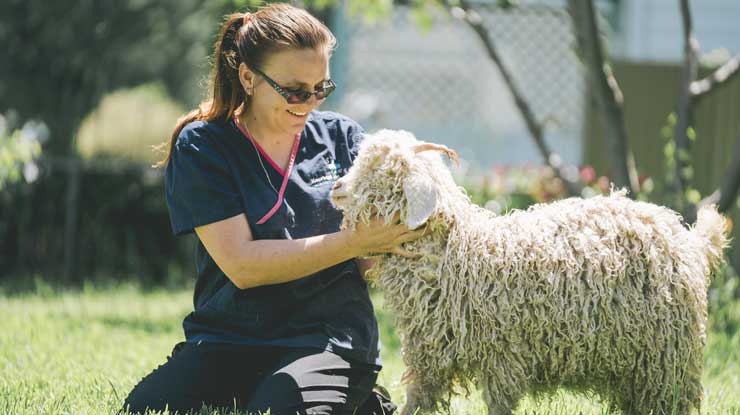 Caption: Riverina veterinarian and Angora goat producer, Dr Kiri Westphalen
Caption: Riverina veterinarian and Angora goat producer, Dr Kiri Westphalen
New study examines sources of Angora reproductive loss
Key points
Riverina veterinarian and Angora goat producer, Dr Kiri Westphalen, has researched the major sources of reproductive loss between joining and weaning in commercial Angora goat flocks.
- New research aimed to identify the major sources of reproductive loss between joining and weaning in Angora goat flocks on commercial properties.
- The study found postnatal kid mortality was the major source of reproductive inefficiency.
- Inadequate pre-joining liveweight is suspected cause of poor conception rates particularly for maidens.
A four-year research project aimed at identifying the major sources of reproductive loss between joining and weaning in commercial Angora goat flocks has produced key insights for goat producers.
Riverina veterinarian and Angora goat producer, Dr Kiri Westphalen, turned the spotlight on her own Angora flock in southern New South Wales to scientifically address anecdotal evidence of poor reproductive efficiency in Angora goats.
Dr Westphalen undertook the study as part of a Master’s Research Degree she has just completed at Charles Sturt University.
Getting into goats
Dr Westphalen first became interested in fibre and wool science while studying veterinary science at Murdoch University, and later had her interest piqued in goats.
She established her Angora flock in 2015 and produces mohair fleece which is exported to South Africa for processing and spinning into fabric utilised by luxury fashion houses such as Armani, to make suits.
“I got my first 20 Angora goats and thought these animals are fabulous, and now I have 120 of them,” Dr Westphalen said.
“I’m a vet and a scientist, I like knowing what I’m doing, but there wasn’t a lot of information out there about goats, let alone Angora goats, so I wanted to fill some of those knowledge gaps.”
What did the research involve?
For the study, Dr Westphalen collected comprehensive reproductive performance records between 2017 and 2021 from her does.
The flock grazed pasture throughout the year except in 2019, when a pen research trial was conducted in which pregnant does were fed differentially during different stages of pregnancy to determine the effects of feeding on the skin follicle density of the progeny.
Does weighing greater than 25kg prior to joining were selected for breeding and each year, 40 to 60 does were mated with two bucks for a nine-week joining starting in early April.
Scanning for pregnancy diagnosis and fetal number occurred eight weeks after removal of the bucks, and daily monitoring of the flock began two weeks before the first expected kidding date in early September.
For each kid born, the dam was identified, and birth type (single, twin) and sex of kid recorded. Kids were marked at weaning and breeding outcome for each doe recorded.
In 2021, autopsies were undertaken on any kids which did not survive, to identify likely causes of death.
What did it find?
Dr Westphalen found that postnatal kid mortality was the major source of reproductive inefficiency.
Mismothering, exposure and copper deficiency were the major causes of mortality, although the area where her property is located near Wagga Wagga is not known for copper deficient soils.
She also believes that inadequate pre-joining liveweight is the cause of poor conception rates, particularly for maidens.
Potential to make big improvements
Dr Westphalen said while the study was conducted in only one flock, there is considerable potential to improve reproductive efficiency.
“Further research on the wider Angora industry is necessary to develop benchmarks for producers to utilise this potential,” Dr Westphalen said.
“I think there has been too much focus on reducing fibre diameter and increasing fleece weight while the reproductive efficiency and survivability of the animal has been ignored.
“We’re producing beautiful animals with low fibre diameters, but they’re not surviving particularly well.
“I would like there to be less of a focus on producing an animal that requires intense care and more focus on producing an animal that is more resilient and can be put out in the paddock and still produce a relatively good quality fleece.
“For us to get the goats to produce the kind of fleeces people are aiming for, you have to intensively feed them and shelter them.
“It means you produce a fine, beautiful product, but from a financial perspective, you’re not improving your returns by supplementary feeding them.
“It would be great if Angoras were more involved in programs such as KIDPLAN, so we can do benchmarking for survivability, birthweight – all those sorts of traits.
“We’re an industry modernising ourselves and moving forward, it would be fabulous if we could put processes in place based on science, so we don’t have to backtrack to fix mistakes of the past.”



